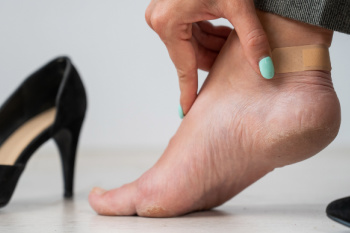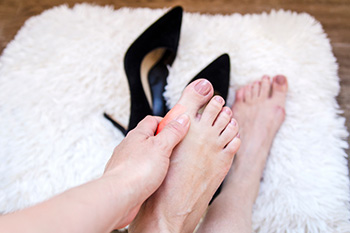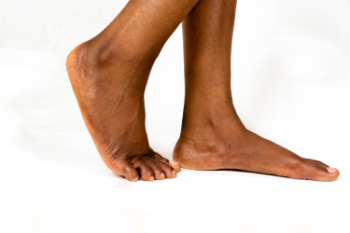Blog
Sesamoiditis Is Painful

Sesamoiditis is an inflammation of the sesamoid bones, which are two small, pea-shaped bones located beneath the big toe joint. These bones are embedded within tendons and play a vital role in absorbing weight-bearing pressure and reducing friction. They also assist with the movement of the big toe during activities like walking and running. Sesamoiditis often occurs in people who engage in activities that put repetitive stress on the ball of the foot, including dancers, runners, and athletes. It can also develop in people with high arches or who frequently wear high heels. Symptoms of sesamoiditis include pain and tenderness beneath the big toe, which typically worsens with activity and improves with rest. To manage sesamoiditis, it is important to reduce pressure on the affected area by wearing cushioned shoes or using orthotic inserts. Rest and anti-inflammatory medications can help to alleviate pain. If symptoms persist, it is suggested that you consult a podiatrist for a proper diagnosis and treatment.
Sesamoiditis is an unpleasant foot condition characterized by pain in the balls of the feet. If you think you’re struggling with sesamoiditis, contact one of our podiatrists of New York Foot and Ankle. Our doctors will treat your condition thoroughly and effectively.
Sesamoiditis
Sesamoiditis is a condition of the foot that affects the ball of the foot. It is more common in younger people than it is in older people. It can also occur with people who have begun a new exercise program, since their bodies are adjusting to the new physical regimen. Pain may also be caused by the inflammation of tendons surrounding the bones. It is important to seek treatment in its early stages because if you ignore the pain, this condition can lead to more serious problems such as severe irritation and bone fractures.
Causes of Sesamoiditis
- Sudden increase in activity
- Increase in physically strenuous movement without a proper warm up or build up
- Foot structure: those who have smaller, bonier feet or those with a high arch may be more susceptible
Treatment for sesamoiditis is non-invasive and simple. Doctors may recommend a strict rest period where the patient forgoes most physical activity. This will help give the patient time to heal their feet through limited activity. For serious cases, it is best to speak with your doctor to determine a treatment option that will help your specific needs.
If you have any questions please feel free to contact one of our offices located in Franklin Square, Bethpage, Brooklyn, and Massapequa, NY . We offer the newest diagnostic and treatment technologies for all your foot and ankle needs.
Friction Blisters on the Feet and How to Prevent Them

Friction blisters on the feet occur when repeated rubbing against the skin causes fluid-filled sacs to form, often leading to pain and discomfort. These blisters typically develop in areas where shoes or socks cause excessive friction. To prevent friction blisters, choosing well-fitting footwear that provides adequate support and cushioning is vital. Opting for moisture-wicking socks helps reduce friction and keeps feet dry. Additionally, using blister prevention tape or pads on areas prone to friction can provide an extra layer of protection. Ensuring that shoes are properly broken in before extensive use also helps to minimize the risk. If you have blisters on your feet that are bothersome or have become infected, it is suggested that you consult a podiatrist who can treat this condition, and offer you effective prevention methods.
Blisters may appear as a single bubble or in a cluster. They can cause a lot of pain and may be filled with pus, blood, or watery serum. If your feet are hurting, contact one of our podiatrists of New York Foot and Ankle. Our doctors can provide the care you need to keep you pain-free and on your feet.
Foot Blisters
Foot blisters are often the result of friction. This happens due to the constant rubbing from shoes, which can lead to pain.
What Are Foot Blisters?
A foot blister is a small fluid-filled pocket that forms on the upper-most layer of the skin. Blisters are filled with clear fluid and can lead to blood drainage or pus if the area becomes infected.
Symptoms
(Blister symptoms may vary depending on what is causing them)
- Bubble of skin filled with fluid
- Redness
- Moderate to severe pain
- Itching
Prevention & Treatment
In order to prevent blisters, you should be sure to wear comfortable shoes with socks that cushion your feet and absorb sweat. Breaking a blister open may increase your chances of developing an infection. However, if your blister breaks, you should wash the area with soap and water immediately and then apply a bandage to the affected area. If your blisters cause severe pain it is important that you call your podiatrist right away.
If you have any questions, please feel free to contact one of our offices located in Franklin Square, Bethpage, Brooklyn, and Massapequa, NY . We offer the newest diagnostic and treatment technologies for all your foot care needs.
Gout Pain Can Be Managed
Why High Heels Are Bad for Your Feet

High heels may look great, but they can cause significant foot problems and impact overall body health. The pressure and angle of high heels can lead to a range of issues, such as bunions, hammertoes, and neuromas, often requiring surgery to correct. Wearing high heels also affects your posture, which can lead to back, leg, and foot pain as the body tries to compensate for the imbalance they create. The altered gait from wearing heels can overwork the hip flexors and knee muscles, increasing the risk of joint and muscle pain. Balance is also compromised, increasing the likelihood of falls and sprained ankles. High heels force the lumbar spine to flatten and the thoracic spine to curve excessively, possibly causing chronic back pain. The continuous flexing of hip muscles can lead to their contraction and shortening, contributing to hip and lower back pain. Consulting a podiatrist can provide valuable insights and treatments tailored to individual needs. If you have foot pain related to wearing high heels, it is suggested that you schedule an appointment with a podiatrist for a diagnosis and treatment.
High heels have a history of causing foot and ankle problems. If you have any concerns about your feet or ankles, contact one of our podiatrists from New York Foot and Ankle. Our doctors can provide the care you need to keep you pain-free and on your feet.
Effects of High Heels on the Feet
High heels are popular shoes among women because of their many styles and societal appeal. Despite this, high heels can still cause many health problems if worn too frequently.
Which Parts of My Body Will Be Affected by High Heels?
- Ankle Joints
- Achilles Tendon – May shorten and stiffen with prolonged wear
- Balls of the Feet
- Knees – Heels cause the knees to bend constantly, creating stress on them
- Back – They decrease the spine’s ability to absorb shock, which may lead to back pain. The vertebrae of the lower back may compress.
What Kinds of Foot Problems Can Develop from Wearing High Heels?
- Corns
- Calluses
- Hammertoe
- Bunions
- Morton’s Neuroma
- Plantar Fasciitis
How Can I Still Wear High Heels and Maintain Foot Health?
If you want to wear high heeled shoes, make sure that you are not wearing them every day, as this will help prevent long term physical problems. Try wearing thicker heels as opposed to stilettos to distribute weight more evenly across the feet. Always make sure you are wearing the proper shoes for the right occasion, such as sneakers for exercising. If you walk to work, try carrying your heels with you and changing into them once you arrive at work. Adding inserts to your heels can help cushion your feet and absorb shock. Full foot inserts or metatarsal pads are available.
If you have any questions please feel free to contact one of our offices located in Franklin Square, Bethpage, Brooklyn, and Massapequa, NY . We offer the newest diagnostic and treatment technologies for all your foot and ankle needs.
Stretching the Achilles Tendon and Understanding Common Injuries

Safely stretching the Achilles tendon is essential for preventing injuries and improving flexibility. Begin with gentle stretches like the calf stretch, where you lean against a wall with one foot behind the other, keeping the back leg straight and heel on the ground. Hold the stretch for 15 to 30 seconds, then switch legs. It is important to avoid overstretching or sudden movements to prevent strain. Common Achilles tendon injuries include tendinitis, an inflammation causing pain and swelling, and Achilles tendon rupture, a severe tear resulting in sudden, intense pain and difficulty walking. Preventing these injuries involves warming up properly, gradually increasing activity intensity, and wearing supportive footwear. If you have sustained an Achilles tendon injury, it is suggested that you consult a podiatrist who can effectively treat this condition.
Achilles tendon injuries need immediate attention to avoid future complications. If you have any concerns, contact one of our podiatrists of New York Foot and Ankle. Our doctors can provide the care you need to keep you pain-free and on your feet.
What Is the Achilles Tendon?
The Achilles tendon is a tendon that connects the lower leg muscles and calf to the heel of the foot. It is the strongest tendon in the human body and is essential for making movement possible. Because this tendon is such an integral part of the body, any injuries to it can create immense difficulties and should immediately be presented to a doctor.
What Are the Symptoms of an Achilles Tendon Injury?
There are various types of injuries that can affect the Achilles tendon. The two most common injuries are Achilles tendinitis and ruptures of the tendon.
Achilles Tendinitis Symptoms
- Inflammation
- Dull to severe pain
- Increased blood flow to the tendon
- Thickening of the tendon
Rupture Symptoms
- Extreme pain and swelling in the foot
- Total immobility
Treatment and Prevention
Achilles tendon injuries are diagnosed by a thorough physical evaluation, which can include an MRI. Treatment involves rest, physical therapy, and in some cases, surgery. However, various preventative measures can be taken to avoid these injuries, such as:
- Thorough stretching of the tendon before and after exercise
- Strengthening exercises like calf raises, squats, leg curls, leg extensions, leg raises, lunges, and leg presses
If you have any questions please feel free to contact one of our offices located in Franklin Square, Bethpage, Brooklyn, and Massapequa, NY . We offer the newest diagnostic tools and technology to treat your foot and ankle needs.
Foot Stretches for Runners
 Foot stretches are vital for runners to prevent injuries and enhance performance. One essential stretch is the calf stretch, which targets the Achilles tendon and calf muscles, improving flexibility and reducing the risk of tendinitis. To perform this, stand facing a wall with one leg extended behind, pressing the heel into the ground while bending the front knee. The plantar fascia stretch is another good exercise. Sit down and cross one leg over the other, pulling the toes back towards the shin to stretch the arch of the foot. This helps prevent plantar fasciitis by loosening the plantar fascia. Toe curls and extensions also strengthen the intrinsic foot muscles. Place a towel on the floor and use your toes to scrunch it up, then spread the toes out wide. Ankle circles enhance joint mobility. Sit or stand and rotate each ankle in both directions, improving blood flow and flexibility. These stretches, performed regularly, help maintain foot health, reduce injury risk, and improve overall running efficiency. If you are a runner and endure persistent foot pain or are prone to injury, it is suggested that you schedule an appointment with a podiatrist for advice.
Foot stretches are vital for runners to prevent injuries and enhance performance. One essential stretch is the calf stretch, which targets the Achilles tendon and calf muscles, improving flexibility and reducing the risk of tendinitis. To perform this, stand facing a wall with one leg extended behind, pressing the heel into the ground while bending the front knee. The plantar fascia stretch is another good exercise. Sit down and cross one leg over the other, pulling the toes back towards the shin to stretch the arch of the foot. This helps prevent plantar fasciitis by loosening the plantar fascia. Toe curls and extensions also strengthen the intrinsic foot muscles. Place a towel on the floor and use your toes to scrunch it up, then spread the toes out wide. Ankle circles enhance joint mobility. Sit or stand and rotate each ankle in both directions, improving blood flow and flexibility. These stretches, performed regularly, help maintain foot health, reduce injury risk, and improve overall running efficiency. If you are a runner and endure persistent foot pain or are prone to injury, it is suggested that you schedule an appointment with a podiatrist for advice.
Stretching the feet is a great way to prevent injuries. If you have any concerns with your feet consult with one of our podiatrists from New York Foot and Ankle. Our doctors will assess your condition and provide you with quality foot and ankle treatment.
Stretching the Feet
Stretching the muscles in the foot is an important part in any physical activity. Feet that are tight can lead to less flexibility and make you more prone to injury. One of the most common forms of foot pain, plantar fasciitis, can be stretched out to help ease the pain. Stretching can not only ease pain from plantar fasciitis but also prevent it as well. However, it is important to see a podiatrist first if stretching is right for you. Podiatrists can also recommend other ways to stretch your feet. Once you know whether stretching is right for you, here are some excellent stretches you can do.
- Using a foam roller or any cylindrical object (a water bottle or soda can will do), roll the object under your foot back and forth. You should also exert pressure on the object. Be sure to do this to both feet for a minute. Do this exercise three times each.
- Similar to the previous one, take a ball, such as a tennis ball, and roll it under your foot while seated and exert pressure on it.
- Grab a resistance band or towel and take a seat. If you are using a towel, fold it length wise. Next put either one between the ball of your foot and heel and pull with both hands on each side towards you. Hold this for 15 seconds and then switch feet. Do this three times for each foot.
- Finally hold your big toe while crossing one leg over the other. Pull the toe towards you and hold for 15 seconds. Once again do this three times per foot.
It is best to go easy when first stretching your foot and work your way up. If your foot starts hurting, stop exercising and ice and rest the foot. It is advised to then see a podiatrist for help.
If you have any questions, please feel free to contact one of our offices located in Franklin Square, Bethpage, Brooklyn, and Massapequa, NY . We offer the newest diagnostic and treatment technologies for all your foot care needs.
Fungus and Other Causes of Thick Toenails

Thick toenails can be more than just a cosmetic issue. They often signal underlying health problems. One of the primary causes of thickened toenails is fungal infections, known as onychomycosis. This occurs when fungi infiltrate through small cracks or cuts in the nail or surrounding skin, where they thrive in the moist environment under the nail bed. This condition can worsen, leading to thicker nails that may change color, emit a foul odor, and become painful. Besides fungal infections, health issues such as psoriasis, congenital disorders, or chronic illnesses can also cause your toenails to thicken. Prompt and proper treatment from a podiatrist is essential, as untreated thick toenails can lead to further complications, including difficulty in walking and wearing shoes comfortably. If you notice a thickening of your toenails, it is suggested that you schedule an appointment with a podiatrist for an exam, diagnosis, and treatment options.
For more information about treatment, contact one of our podiatrists of New York Foot and Ankle. Our doctors can provide the care you need to keep you pain-free and on your feet.
Toenail Fungus Treatment
Toenail fungus is a condition that affects many people and can be especially hard to get rid of. Fortunately, there are several methods to go about treating and avoiding it.
Antifungals & Deterrence
Oral antifungal medicine has been shown to be effective in many cases. It is important to consult with a podiatrist to determine the proper regiment for you, or potentially explore other options.
Applying foot powder on the feet and shoes helps keep the feet free of moisture and sweat.
Sandals or open toed shoes – Wearing these will allow air movement and help keep feet dry. They also expose your feet to light, which fungus cannot tolerate. Socks with moisture wicking material also help as well.
If you have any questions please feel free to contact one of our offices located in Franklin Square, Bethpage, Brooklyn, and Massapequa, NY . We offer the newest diagnostic tools and technology to treat your foot and ankle needs.
Risk Factors for Foot Stress Fractures
 A hairline fracture, or stress fracture, is a small crack or severe bruise within a bone that is common among athletes that are involved in running and jumping. People with osteoporosis are also more prone to developing hairline fractures. These injuries typically result from overuse or repetitive stress, often worsened by inadequate healing time between activities. The bones in the foot are particularly susceptible to stress fractures due to their role in absorbing impact during physical activities. Within the foot, the second and third metatarsals are frequently affected, as well as the heel, ankle bones, and navicular bone. Symptoms primarily include pain that worsens with activity and subsides with rest, swelling, tenderness, and bruising. Factors that can increase the risk of developing a stress fracture include participation in high-impact sports, certain foot structures, and weakened bones due to conditions like osteoporosis. Previous fractures, nutritional deficiencies, and improper equipment or techniques are other risk factors. Diagnosing a stress fracture often involves a physical exam and may require imaging tests like MRIs or bone scans, as X-rays might not detect fractures. If ignored, a stress fracture can worsen into a complete break. If you are experiencing foot pain during exercise, it is suggested that you schedule an appointment with a podiatrist for an exam, diagnosis, and treatment options.
A hairline fracture, or stress fracture, is a small crack or severe bruise within a bone that is common among athletes that are involved in running and jumping. People with osteoporosis are also more prone to developing hairline fractures. These injuries typically result from overuse or repetitive stress, often worsened by inadequate healing time between activities. The bones in the foot are particularly susceptible to stress fractures due to their role in absorbing impact during physical activities. Within the foot, the second and third metatarsals are frequently affected, as well as the heel, ankle bones, and navicular bone. Symptoms primarily include pain that worsens with activity and subsides with rest, swelling, tenderness, and bruising. Factors that can increase the risk of developing a stress fracture include participation in high-impact sports, certain foot structures, and weakened bones due to conditions like osteoporosis. Previous fractures, nutritional deficiencies, and improper equipment or techniques are other risk factors. Diagnosing a stress fracture often involves a physical exam and may require imaging tests like MRIs or bone scans, as X-rays might not detect fractures. If ignored, a stress fracture can worsen into a complete break. If you are experiencing foot pain during exercise, it is suggested that you schedule an appointment with a podiatrist for an exam, diagnosis, and treatment options.
Stress fractures occur when there is a tiny crack within a bone. To learn more, contact one of our podiatrists from New York Foot and Ankle. Our doctors can provide the care you need to keep you pain free and on your feet.
How Are They Caused?
Stress fractures are the result of repetitive force being placed on the bone. Since the lower leg and feet often carry most of the body’s weight, stress fractures are likely to occur in these areas. If you rush into a new exercise, you are more likely to develop a stress fracture since you are starting too much, too soon. Pain resulting from stress fractures may go unnoticed at first, however it may start to worsen over time.
Risk Factors
- Gender – They are more commonly found in women compared to men.
- Foot Problems – People with unusual arches in their feet are more likely to develop stress fractures.
- Certain Sports – Dancers, gymnasts, tennis players, runners, and basketball players are more likely to develop stress fractures.
- Lack of Nutrients – A lack of vitamin D and calcium may weaken the bones and make you more prone to stress fractures
- Weak Bones – Osteoporosis can weaken the bones therefore resulting in stress fractures
Stress fractures do not always heal properly, so it is important that you seek help from a podiatrist if you suspect you may have one. Ignoring your stress fracture may cause it to worsen, and you may develop chronic pain as well as additional fractures.
If you have any questions, please feel free to contact one of our offices located in Franklin Square, Bethpage, Brooklyn, and Massapequa, NY . We offer the newest diagnostic and treatment technologies for all your foot care needs.
Are Bunions Affecting Your Everyday Life?
Common Foot Injuries for Ballerinas

Ballerinas often face various foot injuries due to the intense demands of ballet. One common injury is the stress fracture, resulting from repetitive impact and overuse, particularly in the metatarsal bones. Tendonitis, especially affecting the Achilles tendon, occurs from overextension and strain during jumps and pointe work. Blisters and calluses develop from friction against tight-fitting ballet shoes. Additionally, sprained ankles are frequent due to the constant balancing and quick directional changes. Sesamoiditis, an inflammation of the small bones beneath the big toe, is another injury caused by the pressure of pointe work. Plantar fasciitis, characterized by heel pain, results from excessive strain on the arch of the foot. These injuries highlight the physical challenges ballerinas face, emphasizing the importance of proper technique, conditioning, and foot care in their training. Foot pain can temporarily stop a dancer’s movements. If this applies to you, it is suggested that you confer with a podiatrist who can provide you with relief and treatment methods.
Foot Pain
Foot pain can be extremely painful and debilitating. If you have a foot pain, consult with one of our podiatrists from New York Foot and Ankle. Our doctors will assess your condition and provide you with quality foot and ankle treatment.
Causes
Foot pain is a very broad condition that could be caused by one or more ailments. The most common include:
- Bunions
- Hammertoes
- Plantar Fasciitis
- Bone Spurs
- Corns
- Tarsal Tunnel Syndrome
- Ingrown Toenails
- Arthritis (such as Gout, Rheumatoid, and Osteoarthritis)
- Flat Feet
- Injury (from stress fractures, broken toe, foot, ankle, Achilles tendon ruptures, and sprains)
- And more
Diagnosis
To figure out the cause of foot pain, podiatrists utilize several different methods. This can range from simple visual inspections and sensation tests to X-rays and MRI scans. Prior medical history, family medical history, and any recent physical traumatic events will all be taken into consideration for a proper diagnosis.
Treatment
Treatment depends upon the cause of the foot pain. Whether it is resting, staying off the foot, or having surgery; podiatrists have a number of treatment options available for foot pain.
If you have any questions, please feel free to contact one of our offices located in Franklin Square, Bethpage, Brooklyn, and Massapequa, NY . We offer the newest diagnostic and treatment technologies for all your foot care needs.
More...
Causes and Treatment of Hammertoe

Hammertoe occurs when the muscles around the toe joints contract, causing the toe to bend downward at the middle joint, resembling a hammer. This can lead to significant discomfort and the formation of calluses and corns due to friction. Often, it affects the second toe, especially in cases where it is longer than the big toe, leading to pressure and trauma within tight or ill-fitting shoes. High heels and shoes with a narrow toe box can worsen the condition by exerting extra pressure on the toes. Genetic predisposition, bunions, and physical injuries, such as stubbing or nerve damage, can also contribute to the development of hammertoe. Treatment options vary depending on the severity and flexibility of the toe. For mild cases, a podiatrist might suggest wearing shoes with a wider toe box, using adhesive gel pads, or inserting orthotic devices to alleviate pressure. In more severe cases where the toe becomes rigid and painful, surgical intervention may be necessary to restore normal alignment. If you are experiencing pain from a hammertoe, it is suggested that you make an appointment with a podiatrist for an exam and treatment.
Hammertoe
Hammertoes can be a painful condition to live with. For more information, contact one of our podiatrists from New York Foot and Ankle. Our doctors will answer any of your foot- and ankle-related questions.
Hammertoe is a foot deformity that affects the joints of the second, third, fourth, or fifth toes of your feet. It is a painful foot condition in which these toes curl and arch up, which can often lead to pain when wearing footwear.
Symptoms
- Pain in the affected toes
- Development of corns or calluses due to friction
- Inflammation
- Redness
- Contracture of the toes
Causes
Genetics – People who are genetically predisposed to hammertoe are often more susceptible
Arthritis – Because arthritis affects the joints in your toes, further deformities stemming from arthritis can occur
Trauma – Direct trauma to the toes could potentially lead to hammertoe
Ill-fitting shoes – Undue pressure on the front of the toes from ill-fitting shoes can potentially lead to the development of hammertoe
Treatment
Orthotics – Custom made inserts can be used to help relieve pressure placed on the toes and therefore relieve some of the pain associated with it
Medications – Oral medications such as anti-inflammatories or NSAIDs could be used to treat the pain and inflammation hammertoes causes. Injections of corticosteroids are also sometimes used
Surgery – In more severe cases where the hammertoes have become more rigid, foot surgery is a potential option
If you have any questions please contact one of our offices located in Franklin Square, Bethpage, Brooklyn, and Massapequa, NY . We offer the newest diagnostic and treatment technologies for all your foot and ankle needs.
Managing a Broken Ankle

Managing a broken ankle requires immediate attention from a podiatrist to ensure proper healing and prevent long-term issues. Unlike a sprain, which affects the ligaments surrounding the ankle, a fracture is a more severe injury. It involves one or more of the ankle bones and is often accompanied by torn ligaments and damaged cartilage. Symptoms of a fractured ankle include significant swelling, intense pain, bruising, and an inability to bear weight. Sometimes bones in the ankle joint are misaligned. Common causes of ankle fractures are sports injuries, falls, or missteps on uneven ground. The recovery process involves several stages. Initial swelling may subside within days or weeks, but full recovery and return to normal function can take months. During this time, avoiding undue strain on the injured ankle is necessary to prevent complications and ensure proper healing. Prolonged immobility can lead to weakness and may require additional treatment. While most ankle fractures heal well, there is a risk of developing osteoarthritis or chronic instability, which can increase the likelihood of future injuries. If you believe you have broken your ankle, it is suggested that you make an emergency appointment with a podiatrist for treatment.
Broken ankles need immediate treatment. If you are seeking treatment, contact one of our podiatrists from New York Foot and Ankle. Our doctors can provide the care you need to keep you pain-free and on your feet.
Broken Ankles
A broken ankle is experienced when a person fractures their tibia or fibula in the lower leg and ankle area. Both of these bones are attached at the bottom of the leg and combine to form what we know to be our ankle.
When a physician is referring to a break of the ankle, he or she is usually referring to a break in the area where the tibia and fibula are joined to create our ankle joint. Ankles are more prone to fractures because the ankle is an area that suffers a lot of pressure and stress. There are some obvious signs when a person experiences a fractured ankle, and the following symptoms may be present.
Symptoms of a Fractured Ankle
- Excessive pain when the area is touched or when any pressure is placed on the ankle
- Swelling around the area
- Bruising of the area
- Area appears to be deformed
If you suspect an ankle fracture, it is recommended to seek treatment as soon as possible. The sooner you have your podiatrist diagnose the fracture, the quicker you’ll be on the way towards recovery.
If you have any questions, please feel free to contact one of our offices located in Franklin Square, Bethpage, Brooklyn, and Massapequa, NY . We offer the newest diagnostic and treatment technologies for all your foot care needs.
Treatment of Adult Acquired Flat Feet

Adult-acquired flatfoot, also known as posterior tibial tendon dysfunction, can be a source of significant discomfort for many adults. Adult-acquired flatfoot develops when the posterior tibial tendon weakens, causing the arch of the foot to collapse gradually. Symptoms can include pain along the inside of the ankle, swelling, difficulty standing on tiptoes, and increased discomfort during weight-bearing activities. A podiatrist can perform an assessment of your foot's flexibility and alignment, and may order X-rays or other imaging techniques to assess the condition of the tendon and bones. Treatment options typically start conservatively with custom orthotics or ankle braces to support the foot and alleviate pain. Activity modifications and anti-inflammatory medications may also be recommended. In cases where conservative treatments do not provide sufficient relief, surgical tendon repair or fusion procedures may be considered to restore stability and function to the affected foot. If you are experiencing problems related to flat feet, it is suggested that you schedule an appointment with a podiatrist for treatment.
Flatfoot is a condition many people suffer from. If you have flat feet, contact one of our podiatrists from New York Foot and Ankle. Our doctors will treat your foot and ankle needs.
What Are Flat Feet?
Flatfoot is a condition in which the arch of the foot is depressed and the sole of the foot is almost completely in contact with the ground. About 20-30% of the population generally has flat feet because their arches never formed during growth.
Conditions & Problems:
Having flat feet makes it difficult to run or walk because of the stress placed on the ankles.
Alignment – The general alignment of your legs can be disrupted, because the ankles move inward which can cause major discomfort.
Knees – If you have complications with your knees, flat feet can be a contributor to arthritis in that area.
Symptoms
- Pain around the heel or arch area
- Trouble standing on the tip toe
- Swelling around the inside of the ankle
- Flat look to one or both feet
- Having your shoes feel uneven when worn
Treatment
If you are experiencing pain and stress on the foot you may weaken the posterior tibial tendon, which runs around the inside of the ankle.
If you have any questions please feel free to contact one of our offices located in Franklin Square, Bethpage, Brooklyn, and Massapequa, NY . We offer the newest diagnostic and treatment technologies for all your foot and ankle needs.



